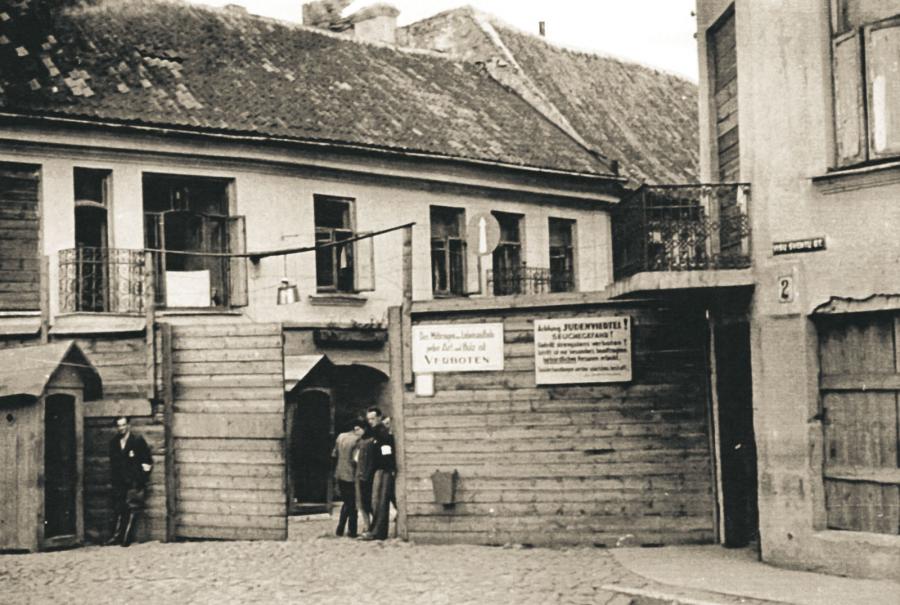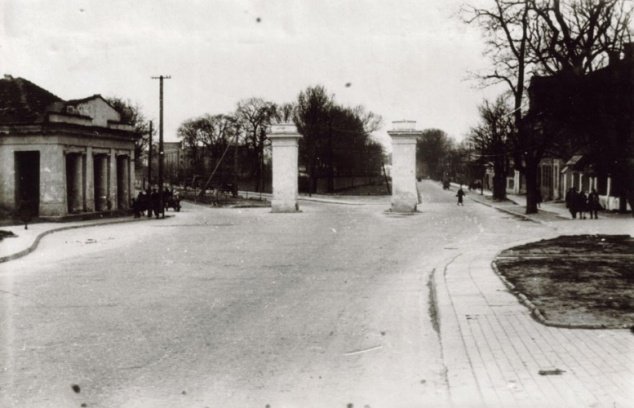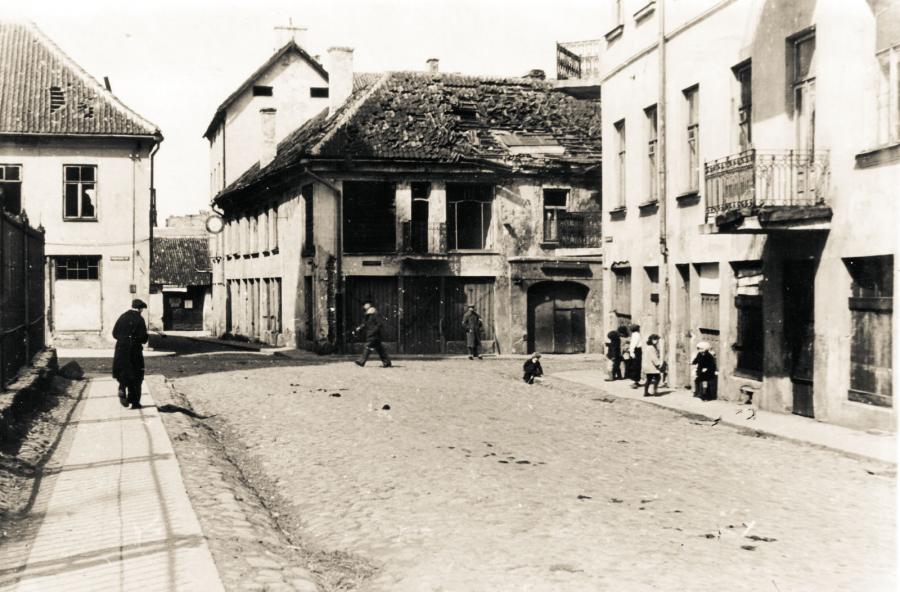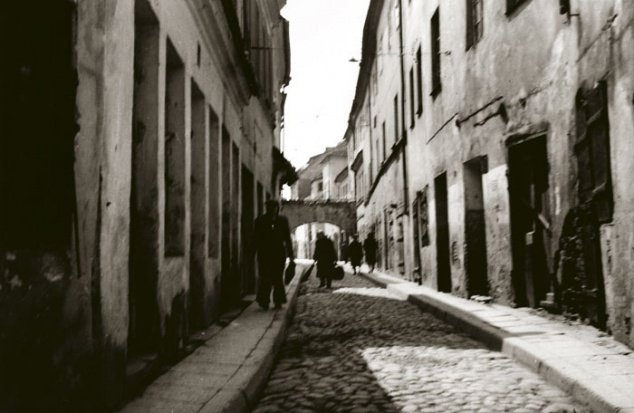Today marks the 75th anniversary of the liquidation of the Great Vilnius Ghetto. Before the establishment of the ghetto, about 57 Jews lived in Vilnius, after the end of the war only about two thousand remained alive.
The ghetto was established in the Jewish quarter, which was west of the Great Street, reaching Dominikonoi and Vokiečiai Streets. During the Second World War, the so-called Small Jewish Ghetto (Stiklių, Gaono, Antokolskio, Žydų str.) also operated here for a short time, where about 11-12 thousand people lived. people, mainly intellectuals, black workers and unemployed persons. The small ghetto remained until 1941.
The Great Synagogue, which could accommodate about 3-5 thousand people, was bustling on Žydų Street. worshipers and 18 Torah scrolls were kept. Adjacent were the Gaon's prayer house, the famous Strašūnas library, and other buildings of religious purpose in the synagogue courtyard. All this was finally destroyed by the Soviet authorities. Today, there is a kindergarten on the site of the Great Synagogue, and a monument to the Gaon was built next to it, in the place where his house was. Narrow and crooked streets with transverse arcades have retained their original appearance, some ancient architecture has been preserved or restored: first of all, houses on Stiklių and Gaonos streets.

The Great Vilnius Ghetto existed since 1941. September 6 until September 1943, 23 (on the streets of Lyda, Rūdninkai, Mēsinių, Ashmena, Žemaitija, Dysna, Šiauliai, Ligoninė). There were about 29 Jews in the Great Ghetto, most of whom were killed in Paneri. Rūdninkai st. 000 is the location of the main gate to the Great Ghetto, marked by a memorial board with a plan of the ghetto. The block between Ašmena, Dysna and Mėsinių streets is the first block of restored historic Vilnius, where the Jewish Culture and Information Center operates. Žemaitija Street 18–1921 was called after M. Strašūnas. The books collected by Matitjachus Strašunas were the basis of Europe's largest Judaica library (1951), which was destroyed together with the Great Synagogue. After Lithuania regained its independence, the day of the liquidation of the Great Vilnius Ghetto (September 1892) was declared the day of remembrance of the victims of the genocide of the Jews of Lithuania.
Creation of the Vilnius ghetto
As soon as Germany entered Lithuania, the persecution and killing of Jews began. In Vilnius, Jewish men were arrested on the streets, put in the Lukiškii prison, then taken to the Paneriai Forest and shot there. Relatives were told that they were being taken away for work and would return soon.

Finally, as in other German-occupied cities, Vilnius in the old town in 1941 September 6 a Jewish ghetto was established. At that time, about 57 thousand Jews lived in Vilnius, during the entire period of the ghetto's life, about 50 thousand people were imprisoned in the ghetto.
The ghetto was made up of two parts, the Great and the Little Ghetto. There were about 30 Jews in the Great Ghetto, and about 11 in the Small Ghetto. The ghettos were separated by the current Vokiečiai street. In the Great Ghetto, the Jewish Council (Judenrat) was headed by Anatolis Fridas, and in the Small Ghetto by Aizikas Leibovičius. It was also created by the Jews police, which was headed by Jakov Gens. At first, the Jews hoped that they would live in the ghetto for a very long time, that the punishment actions and arbitrariness would end. But such hopes were quickly dashed. Already in 1941 about 18 thousand Jews were killed during the actions carried out. On September 13, named "Rabbi's Day", the Germans took away and killed Jewish rabbis in Paneri, on October 1. after the organization of the Great Judgment Action, praying Jews were forcibly dragged from synagogues and sent to be shot.
Until October 21 Only about 2500 "necessaries" - people fit for work - were left in the Small Ghetto, who were herded into the Great Ghetto.

In order to "select" the Jews needed by the Nazi government, "shains" were used, the holders of which could work and survive. The Jewish police also took part in the division of Shaina. Of course, they not only decided who should live, but also tried to save the Jews. Those without shaina were condemned to death. Every few weeks, new colored shainas were introduced, which were always outnumbered by people. On October 24, after the distribution of yellow shins on November 3-5, about 8 thousand Jews of the Great Ghetto were left without them, and they were destroyed. Those with yellow shins were driven to the Little Ghetto. Then the Great Ghetto was searched and the Jews hiding in it were destroyed. Finally, he was allowed to return to the Great Ghetto.
Until 1941 at the end of December, the Germans killed 57 out of 33 Vilnius Jews. Only 500 legal Jews and 12 illegal Jews who hid in hiding places remained in the ghetto.
Hoping to hide, the Jews began to build hiding places in the ghetto itself. They were built in attics, deep underground, for one or several people. Many hours had to be spent in them during inspections. Sometimes they were very short of air and because of that not everyone got out of them alive. Elderly people and children were dying.
Stabilization
Since 1942 until 1943 In the spring ghetto, the mass extermination campaigns were stopped. Back then, most of the ghetto residents worked in various jobs.
in 1942 July 15 the Germans appointed Jakov Gens as the dictatorial head of the Jewish police and ghetto. J. Gens was married to a Lithuanian woman who lived with their daughter outside the ghetto territory and had the opportunity to escape, but decided to stay in the ghetto with her people. Some respected Mr. Gensas as their leader and guarantee of life, while others condemned him.
Hospital
There was a hospital in the ghetto that provided medical care. The biggest problem of the hospital was the constant lack of medicines. Medicines were collected from the ghetto residents, murdered people, finally started to be smuggled, and some were even made by themselves. Living in a very cramped environment, there was a constant threat of an epidemic, so doctors tried their best to enforce hygiene. There were only two saunas in the ghetto and residents did not receive a card for bread until they presented a certificate that they bathed in the sauna at least once a month.

In the absence of drugs, there were acute shortages of calcium, needed for epilepsy, and insulin, needed to treat people with diabetes. Due to the lack of calcium, a consilium was convened consisting of doctors, rabbis and jurists. It was suggested either to reduce the amount of medicine for everyone, which would be disastrous for some patients, or to give calcium only to a part of the patients. There was no answer as to what to do, and after two months the calcium ran out and all the patients died. There were also about 50 diabetic patients in the ghetto who constantly needed insulin. in 1942 at the beginning of winter, it was already clear that insulin supplies could run out quickly. A council was called again and again no answer was received. Doctors then independently made the decision to extend the lives of those whose disease was less advanced.
Spiritual life
Despite the terrible living conditions and fear, the ghetto had an orchestra, two choirs, a music school with 100 students, two primary schools and one secondary school. Zelikas Kalmanovičius worked in the building outside the ghetto area (Vivulskio Street 18), who collected and cataloged Jewish objects that he was preparing to send to Frankfurt and then to Prague, where he planned to establish a museum of the enslaved nation and culture.

At that time, political disputes continued, and when schools and kindergartens were opened, the question arose as to which language to teach. Despite starvation in the ghetto, there were a few canteens that served kosher food. There was also a library, a reading room, an archive, a statistics department and a ghetto museum. House on Strašiūnai street no. 6 (now Žemaitijos St. 4) was called the ghetto culture house. There, thousands of documents were collected from the beginning of the ghetto: police orders, reports, testimonies of those who managed to escape from the Paneriai forest. The statistics department collected data on the activities of the ghetto institutions and published them in reports and charts.
A theater, a symphony and a jazz orchestra were created in the ghetto. Their creation caused conflicting feelings among the ghetto residents. Some thought that it was impossible to have fun at such a time. The creation of the theater caused a particularly big storm in the ghetto. However, Jakov Gens insisted that it be opened, saving "unnecessary" residents.
Eventually, the theater became an integral part of ghetto life. About 150 plays were staged there. The hall was always crowded.
Resistance movement
Some Jews protested this treatment by the Germans, but they were simply killed. At the beginning of the creation of the ghetto, an underground movement was established, the leaders of which became the leaders of the pre-war youth movement. Finally in 1942 At the beginning, the underground movement turned into armed resistance. Two underground organizations were created in the ghetto - JPO (Joint Partisan Organization) and Jochel Šeinboim's group "Dror" (Struggle). JPO was headed by Iciks Vitenbergas (chairman of the communist youth organization). It had about 350 soldiers. Jechiel's group "Dror" consisted of 200 soldiers.
JPO leaders decided to organize an armed uprising. At that time, the leaders of Jechiel's group suggested that they withdraw into the forest to join the red partisans there.

in 1942 January 1 the underground issued a warning: "Do not go like sheep to the slaughterhouse!", invited the people to speak up and resist. Both groups sought connections with Polish and Lithuanian underground organizations that operated outside the ghetto area. The Polish national organization categorically refused, and the Lithuanian communist underground organization promised to help. There was also an intensive search for weapons.
in 1943 On July 16, one of the two members of the underground council of the Communist Party arrested by the German police for the interrogation of the mayor betrayed the head of the JPO, Wittenberg. The Nazis demanded the extradition of Wittenberg.
This was what Gens was told to do. He called the armed police and other people. People, fearing that the Germans would not destroy the ghetto, asked to hand over the leader of the uprising. There was such a situation that in order to start an uprising, it was necessary to clear the way between the people who stood with axes, clubs and even weapons that they received from the Germans. Finally, Wittenberg himself decided to surrender.

in 1943 September 1 the Gestapo and its helpers entered the ghetto and deported the Jews to concentration camps in Estonia. Only one of Scheinboim's squad managed to start shooting, part of it was killed immediately, the other part managed to escape into the forest and join the red partisan movement there.
Liquidation of the ghetto
Since 1943 At the beginning of spring, the Germans began to systematically destroy the ghettos of Lithuania, and it was the turn of the Vilnius ghetto. The Germans used the Jewish police to destroy the Jews living in the vicinity, and then the Vilnius ghetto itself.

After the final selection, 5000 Jews were temporarily saved and housed in the Vilnius ghetto. Finally, on September 14 and Jacob Gens himself was killed. It was clear that this was the beginning of the end. in 1943 September 23-24 The Vilnius ghetto was finally liquidated.

